Evaluating the Potential of Landsat Satellite Data to Monitor the Effectiveness of Measures to Mitigate Urban Heat Islands: A Case Study for Stuttgart (Germany)
Abstract
1. Introduction
2. Materials and Methods
2.1. Data
2.2. Methods
2.3. Categorisation of Land Cover Changes
3. Results
3.1. SUHI in Stuttgart and Its Temporal Change between 2004–2008 and 2016–2020
3.2. Extreme Warming and Cooling Spots of SUHI
4. Discussion
4.1. Robustness of LST and SUHI Trends
4.2. Drivers of Warming and Cooling Spots
4.3. Limitations of the Study
5. Conclusions
Author Contributions
Funding
Institutional Review Board Statement
Informed Consent Statement
Data Availability Statement
Acknowledgments
Conflicts of Interest
Appendix A
| Tile | Date | Satellite |
|---|---|---|
| LT05_L2SP_195026_20040730_20200903_02_T1 | 30 July 2004 | L5 |
| LT05_L2SP_195026_20050717_20200902_02_T1 | 17 July 2005 | L5 |
| LT05_L2SP_194026_20060611_20200901_02_T1 | 11 June 2006 | L5 |
| LT05_L2SP_195026_20060618_20200901_02_T1 | 18 June 2006 | L5 |
| LT05_L2SP_194026_20070716_20200830_02_T1 | 16 July 2007 | L5 |
| LT05_L2SP_194026_20070801_20200830_02_T1 | 1 August 2007 | L5 |
| LT05_L2SP_194026_20080702_20200829_02_T1 | 2 July 2008 | L5 |
| LC08_L2SP_194026_20160825_20200906_02_T1 | 25 August 2016 | L8 |
| LC08_L2SP_195026_20170718_20200903_02_T1 | 18 July 2017 | L8 |
| LC08_L2SP_194026_20180714_20200831_02_T1 | 14 July 2018 | L8 |
| LC08_L2SP_194026_20190818_20200827_02_T1 | 18 August 2019 | L8 |
| LC08_L2SP_195026_20190724_20200827_02_T1 | 24 July 2019 | L8 |
| LC08_L2SP_194026_20200820_20200905_02_T1 | 20 August 2020 | L8 |
| LC08_L2SP_195026_20200624_20200823_02_T1 | 24 June 2020 | L8 |
| ID | Name | Longitude | Latitude | Elevation [m] | Location |
|---|---|---|---|---|---|
| 4926 | Stuttgart (Neckartal) | 9.216739 | 48.789592 | 224 | urban |
| 4928 | Stuttgart (Schnarrenberg) | 9.200028 | 48.828085 | 314 | urban |
| 3278 | Metzingen | 9.273366 | 48.537658 | 354 | rural |
| 4160 | Renningen-Ihinger Hof | 8.923969 | 48.742509 | 478 | rural |
| 4349 | Sachsenheim | 9.071028 | 48.95689 | 248 | rural |
| 4931 | Stuttgart-Echterdingen | 9.223535 | 48.688307 | 371 | rural |
| 6275 | Notzingen | 9.462662 | 48.670482 | 325 | rural |
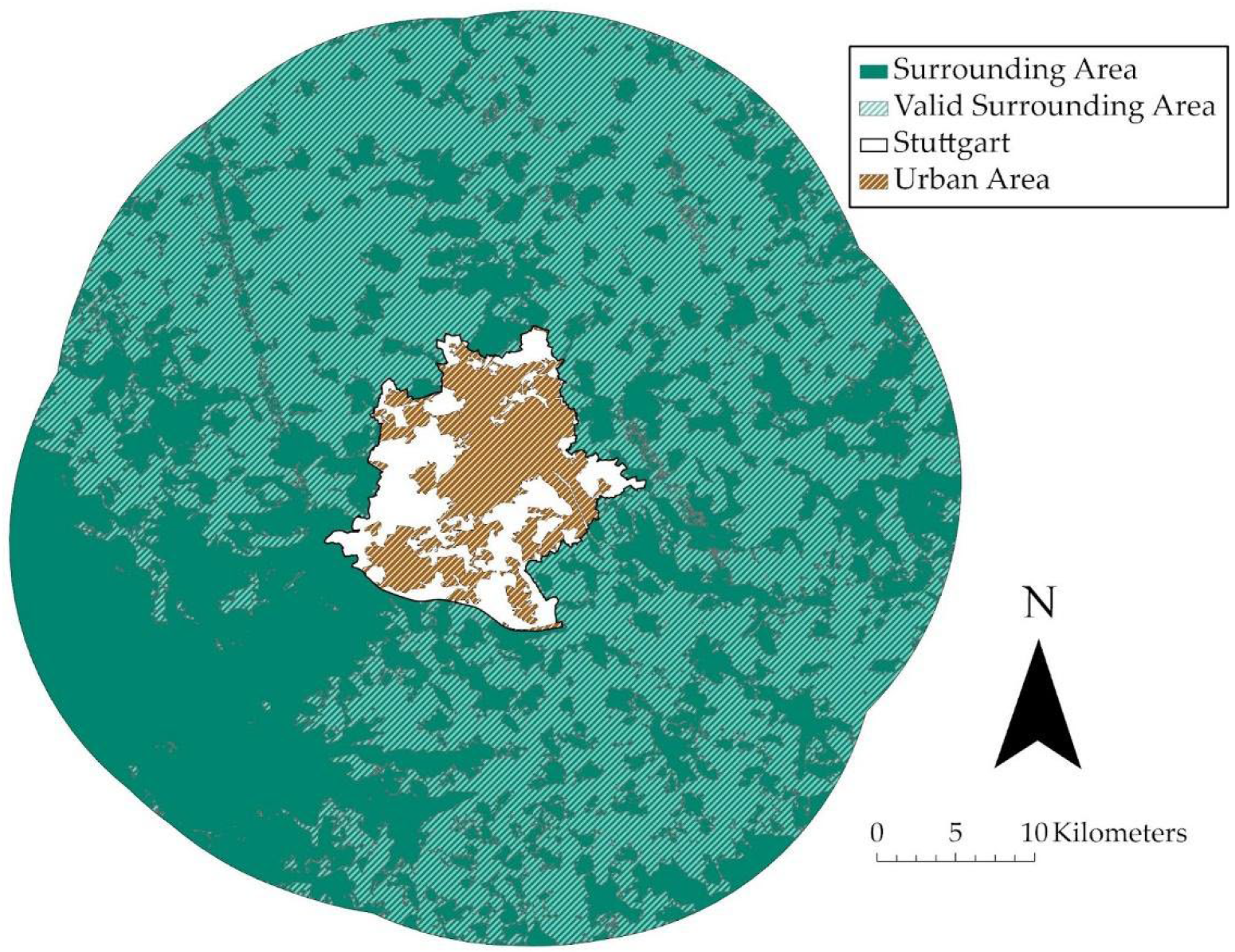
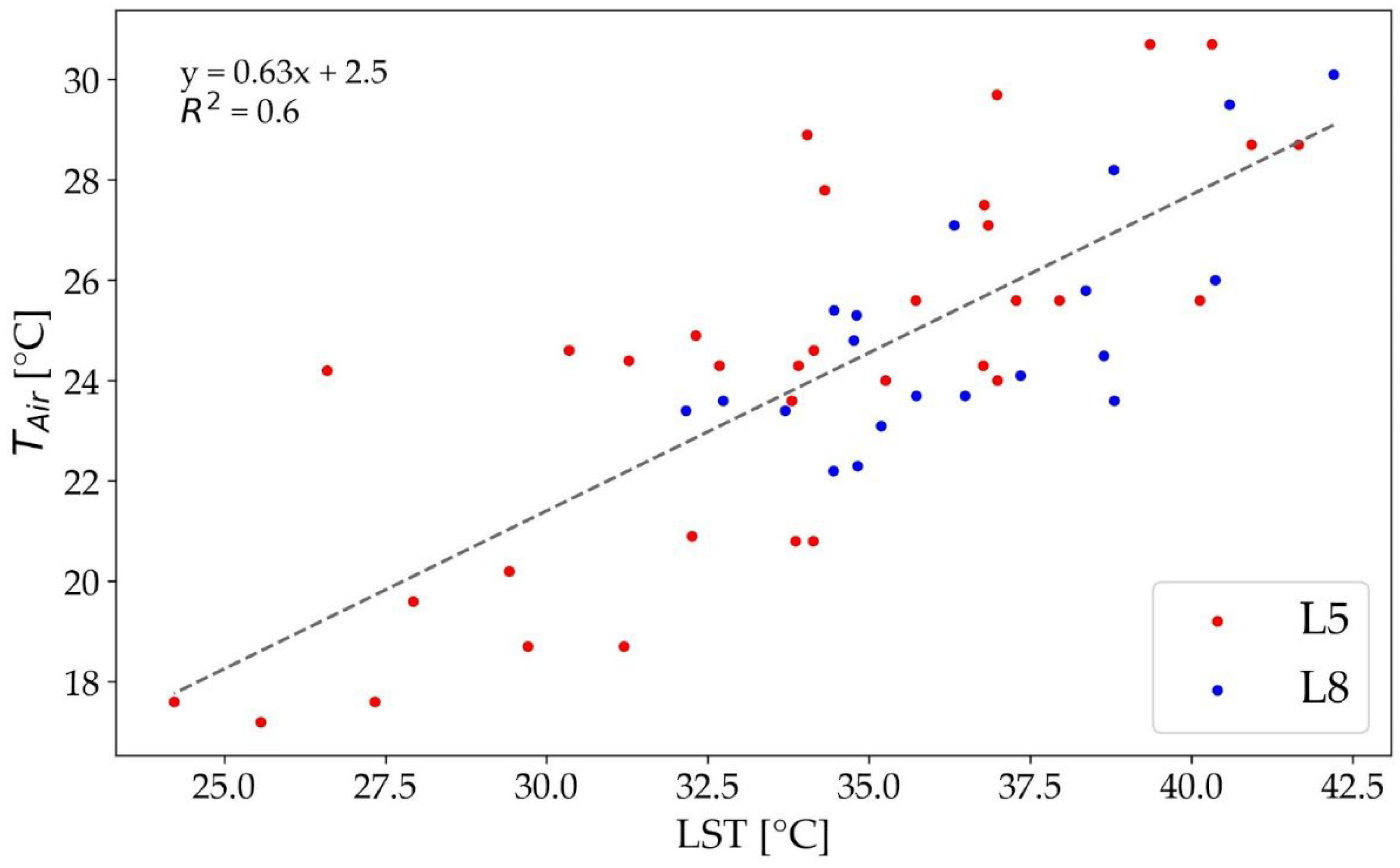
References
- IPCC. Summary for Policymakers. In Climate Change 2022: Impacts, Adaptation, and Vulnerability. Contribution of Working Group II to the Sixth Assessment Report of the Intergovernmental Panel on Climate Change; Pörtner, H.-O., Roberts, D.C., Tignor, M., Poloczanska, E.S., Mintenbeck, K., Alegría, A., Craig, M., Langsdorf, S., Löschke, S., Möller, V., et al., Eds.; Cambridge University Press: Cambridge, UK, 2022; in press. [Google Scholar]
- Mohajerani, A.; Bakaric, J.; Jeffrey-Bailey, T. The urban heat island effect, its causes, and mitigation, with reference to the thermal properties of asphalt concrete. J. Environ. Manag. 2017, 197, 522–538. [Google Scholar] [CrossRef] [PubMed]
- Zacharias, S.; Koppe, C.; Mücke, H. Climate Change Effects on Heat Waves and Future Heat Wave-Associated IHD Mortality in Germany. Climate 2014, 3, 100–117. [Google Scholar] [CrossRef]
- Otto, A.; Göpfert, C.; Thieken, A.H. Are cities prepared for climate change? An analysis of adaptation readiness in 104 German cities. Mitig. Adapt. Strateg. Glob. Chang. 2021, 26, 35. [Google Scholar] [CrossRef]
- Mirzaei, P.A.; Haghighat, F. Approaches to study Urban Heat Island—Abilities and limitations. Build. Environ. 2010, 45, 2192–2201. [Google Scholar] [CrossRef]
- Rani, M.; Kumar, P.; Pandey, P.C.; Srivastava, P.K.; Chaudhary, B.S.; Tomar, V.; Mandal, V.P. Multi-temporal NDVI and surface temperature analysis for Urban Heat Island inbuilt surrounding of sub-humid region: A case study of two geographical regions. Remote Sens. Appl. Soc. Environ. 2018, 10, 163–172. [Google Scholar] [CrossRef]
- Arifin, S.S.; Hamzah, B.; Mulyadi, R.; Rasyid, A.R. Effects of Vegetation on Urban Heat Island Using Landsat 8 OLI/TIRS Imagery in Tropical Urban Climate. Civ. Eng. Archit. 2022, 10, 395–405. [Google Scholar] [CrossRef]
- Naserikia, M.; Asadi Shamsabadi, E.; Rafieian, M.; Leal Filho, W. The Urban Heat Island in an Urban Context: A Case Study of Mashhad, Iran. Int. J. Environ. Res. Public. Health 2019, 16, 313. [Google Scholar] [CrossRef]
- Pal, S.; Ziaul, S. Detection of land use and land cover change and land surface temperature in English Bazar urban centre. Egypt. J. Remote Sens. Space Sci. 2017, 20, 125–145. [Google Scholar] [CrossRef]
- Hsu, A.; Sheriff, G.; Chakraborty, T.; Manya, D. Disproportionate exposure to urban heat island intensity across major US cities. Nat. Commun. 2021, 12, 2721. [Google Scholar] [CrossRef]
- Chen, L.; Jiang, R.; Xiang, W.-N. Surface Heat Island in Shanghai and Its Relationship with Urban Development from 1989 to 2013. Adv. Meteorol. 2016, 2016, 9782686. [Google Scholar] [CrossRef]
- Sejati, A.W.; Buchori, I.; Rudiarto, I. The spatio-temporal trends of urban growth and surface urban heat islands over two decades in the Semarang Metropolitan Region. Sustain. Cities Soc. 2019, 46, 101432. [Google Scholar] [CrossRef]
- Deilami, K.; Kamruzzaman, M.; Liu, Y. Urban heat island effect: A systematic review of spatio-temporal factors, data, methods, and mitigation measures. Int. J. Appl. Earth Obs. Geoinf. 2018, 67, 30–42. [Google Scholar] [CrossRef]
- Chen, W.; Zhang, Y.; Pengwang, C.; Gao, W. Evaluation of Urbanization Dynamics and its Impacts on Surface Heat Islands: A Case Study of Beijing, China. Remote Sens. 2017, 9, 453. [Google Scholar] [CrossRef]
- Mathew, A.; Khandelwal, S.; Kaul, N. Investigating spatial and seasonal variations of urban heat island effect over Jaipur city and its relationship with vegetation, urbanization and elevation parameters. Sustain. Cities Soc. 2017, 35, 157–177. [Google Scholar] [CrossRef]
- Jiahua, Z.; Yingyu, H.; Guicai, L.; Hao, Y.; Limin, Y.; Fengmei, Y. The diurnal and seasonal characteristics of urban heat island variation in Beijing city and surrounding areas and impact factors based on remote sensing satellite data. Sci. China Ser. D Earth Sci. 2005, 48, 220. [Google Scholar] [CrossRef]
- Miles, V.; Esau, I. Seasonal and Spatial Characteristics of Urban Heat Islands (UHIs) in Northern West Siberian Cities. Remote Sens. 2017, 9, 989. [Google Scholar] [CrossRef]
- Sahoo, S.; Majumder, A.; Swain, S.; Gareema; Pateriya, B.; Al-Ansari, N. Analysis of Decadal Land Use Changes and Its Impacts on Urban Heat Island (UHI) Using Remote Sensing-Based Approach: A Smart City Perspective. Sustainability 2022, 14, 11892. [Google Scholar] [CrossRef]
- Sarah, J.; Louis, M.; Esae, O.E. An Eleven Years Analysis of the Seasonal Dynamics of Urban Heat Island (UHI) Intensity (2004–2014). Int. J. Geogr. Geol. 2020, 9, 55–70. [Google Scholar] [CrossRef]
- Mäding, A. Informationen zur Einwohnerentwicklung. Available online: https://www.domino1.stuttgart.de/web/komunis/komunissde.nsf/fc223e09e4cb691ac125723c003bfb31/4e6620005e228f76c12584d300483532/$FILE/bs701_.PDF (accessed on 28 July 2022).
- Historische Monatliche Stationsbeobachtungen (Temperatur, Druck, Niederschlag, Sonnenscheindauer, etc.) für Deutschland; Version v21.3; DWD Climate Data Center (CDC): Offenbach, Germany, 2021.
- Rehan, R.M. Cool city as a sustainable example of heat island management case study of the coolest city in the world. HBRC J. 2016, 12, 191–204. [Google Scholar] [CrossRef]
- Stadtklima Stuttgart|Klima in Stuttgart|Das Klima von Stuttgart. Available online: https://www.stadtklima-stuttgart.de/index.php?klima_klimainstuttgart (accessed on 19 May 2022).
- Ketterer, C.; Matzarakis, A. Comparison of different methods for the assessment of the urban heat island in Stuttgart, Germany. Int. J. Biometeorol. 2015, 59, 1299–1309. [Google Scholar] [CrossRef]
- Fallmann, J.; Forkel, R.; Emeis, S. Secondary effects of urban heat island mitigation measures on air quality. Atmos. Environ. 2016, 125, 199–211. [Google Scholar] [CrossRef]
- Zafrir, R.; Ojeda, S.; Singh, H.; Hahn, M. Seasons in Stuttgart: Developing a Google Earth Engine Tool for Heat Island Mapping. Int. Arch. Photogramm. Remote Sens. Spatial Inf. Sci. 2019, XLII-4/W18, 1123–1130. [Google Scholar] [CrossRef]
- Masek, J.G.; Vermote, E.F.; Saleous, N.E.; Wolfe, R.; Hall, F.G.; Huemmrich, K.F.; Gao, F.; Kutler, J.; Lim, T.-K. A Landsat Surface Reflectance Dataset for North America, 1990–2000. IEEE Geosci. Remote Sens. Lett. 2006, 3, 68–72. [Google Scholar] [CrossRef]
- Cook, M. Atmospheric Compensation for a Landsat Land Surface Temperature Product. Ph.D. Thesis, Rochester Institute of Technology, Rochester, NY, USA, 22 October 2014. [Google Scholar]
- Cook, M.; Schott, J.; Mandel, J.; Raqueno, N. Development of an Operational Calibration Methodology for the Landsat Thermal Data Archive and Initial Testing of the Atmospheric Compensation Component of a Land Surface Temperature (LST) Product from the Archive. Remote Sens. 2014, 6, 11244–11266. [Google Scholar] [CrossRef]
- Vermote, E.; Justice, C.; Claverie, M.; Franch, B. Preliminary analysis of the performance of the Landsat 8/OLI land surface reflectance product. Remote Sens. Environ. 2016, 185, 46–56. [Google Scholar] [CrossRef] [PubMed]
- Landsat Collection 2 Surface Temperature|U.S. Geological Survey. Available online: https://www.usgs.gov/landsat-missions/landsat-collection-2-surface-temperature (accessed on 24 June 2022).
- Landsat 7|U.S. Geological Survey. Available online: https://www.usgs.gov/landsat-missions/landsat-7 (accessed on 27 May 2022).
- USGS. Landsat 4-7 Collection 2 (C2) Level 2 Science Product (L2SP) Guide 2021. Available online: https://d9-wret.s3.us-west-2.amazonaws.com/assets/palladium/production/s3fs-public/media/files/LSDS-1618_Landsat-4-7_C2-L2-ScienceProductGuide-v4.pdf (accessed on 8 June 2022).
- USGS. Landsat 8-9 Collection 2 (C2) Level 2 Science Product (L2SP) Guide 2022. Available online: https://d9-wret.s3.us-west-2.amazonaws.com/assets/palladium/production/s3fs-public/media/files/LSDS-1619_Landsat-8-9-C2-L2-ScienceProductGuide-v4.pdf (accessed on 8 June 2022).
- Fact Sheet. In USGS Landsat—Earth Observation Satellites; U.S. Geological Survey: Reston, VA, USA, 2016; Volume 2015–3081, p. 4. [CrossRef]
- Blockiness Artifact in Landsat Collection 2 Surface Temperature Products|U.S. Geological Survey. Available online: https://www.usgs.gov/landsat-missions/blockiness-artifact-landsat-collection-2-surface-temperature-products (accessed on 18 May 2022).
- Malakar, N.K.; Hulley, G.C.; Hook, S.J.; Laraby, K.; Cook, M.; Schott, J.R. An Operational Land Surface Temperature Product for Landsat Thermal Data: Methodology and Validation. IEEE Trans. Geosci. Remote Sens. 2018, 56, 5717–5735. [Google Scholar] [CrossRef]
- Duan, S.-B.; Li, Z.-L.; Zhao, W.; Wu, P.; Huang, C.; Han, X.-J.; Gao, M.; Leng, P.; Shang, G. Validation of Landsat land surface temperature product in the conterminous United States using in situ measurements from SURFRAD, ARM, and NDBC sites. Int. J. Digit. Earth 2021, 14, 640–660. [Google Scholar] [CrossRef]
- Chen, F.; Yang, S.; Yin, K.; Chan, P. Challenges to quantitative applications of Landsat observations for the urban thermal environment. J. Environ. Sci. 2017, 59, 80–88. [Google Scholar] [CrossRef] [PubMed]
- Zhu, Z.; Fu, Y.; Woodcock, C.E.; Olofsson, P.; Vogelmann, J.E.; Holden, C.; Wang, M.; Dai, S.; Yu, Y. Including land cover change in analysis of greenness trends using all available Landsat 5, 7, and 8 images: A case study from Guangzhou, China (2000–2014). Remote Sens. Environ. 2016, 185, 243–257. [Google Scholar] [CrossRef]
- Li, P.; Jiang, L.; Feng, Z. Cross-Comparison of Vegetation Indices Derived from Landsat-7 Enhanced Thematic Mapper Plus (ETM+) and Landsat-8 Operational Land Imager (OLI) Sensors. Remote Sens. 2014, 6, 310–329. [Google Scholar] [CrossRef]
- Wessel, B.; Huber, M.; Wohlfart, C.; Marschalk, U.; Kosmann, D.; Roth, A. Accuracy assessment of the global TanDEM-X Digital Elevation Model with GPS data. ISPRS J. Photogramm. Remote Sens. 2018, 139, 171–182. [Google Scholar] [CrossRef]
- Rizzoli, P.; Martone, M.; Gonzalez, C.; Wecklich, C.; Borla Tridon, D.; Bräutigam, B.; Bachmann, M.; Schulze, D.; Fritz, T.; Huber, M.; et al. Generation and performance assessment of the global TanDEM-X digital elevation model. ISPRS J. Photogramm. Remote Sens. 2017, 132, 119–139. [Google Scholar] [CrossRef]
- Büttner, G.; Kosztra, B.; Soukup, T.; Sousa, A.; Langanke, T. CLC2018 Technical Guidelines 61; EEA: Vienna, Austria, 2017. [Google Scholar]
- Open Data und Testdaten. Available online: https://www.stuttgart.de/leben/bauen/geoportal/open-data-und-testdaten.php (accessed on 19 May 2022).
- DWD Climate Data Center (CDC): Hourly station observations of air temperature at 2 m above ground in °C for Germany, version v19.3. Available online: https://cdc.dwd.de/portal/ (accessed on 6 September 2021).
- Macintyre, H.L.; Heaviside, C.; Cai, X.; Phalkey, R. The winter urban heat island: Impacts on cold-related mortality in a highly urbanized European region for present and future climate. Environ. Int. 2021, 154, 106530. [Google Scholar] [CrossRef] [PubMed]
- Debbage, N.; Shepherd, J.M. The urban heat island effect and city contiguity. Comput. Environ. Urban Syst. 2015, 54, 181–194. [Google Scholar] [CrossRef]
- Oke, T.R. The energetic basis of the urban heat island. Q. J. R. Meteorol. Soc. 1982, 108, 1–24. [Google Scholar] [CrossRef]
- Morini, E.; Touchaei, A.; Castellani, B.; Rossi, F.; Cotana, F. The Impact of Albedo Increase to Mitigate the Urban Heat Island in Terni (Italy) Using the WRF Model. Sustainability 2016, 8, 999. [Google Scholar] [CrossRef]
- Hu, A.; Levis, S.; Meehl, G.A.; Han, W.; Washington, W.M.; Oleson, K.W.; van Ruijven, B.J.; He, M.; Strand, W.G. Impact of solar panels on global climate. Nat. Clim. Chang. 2016, 6, 290–294. [Google Scholar] [CrossRef]
- Luyssaert, S.; Jammet, M.; Stoy, P.C.; Estel, S.; Pongratz, J.; Ceschia, E.; Churkina, G.; Don, A.; Erb, K.; Ferlicoq, M.; et al. Land management and land-cover change have impacts of similar magnitude on surface temperature. Nat. Clim. Chang. 2014, 4, 389–393. [Google Scholar] [CrossRef]
- Kim, J.-P.; Guldmann, J.-M. Land-Use Planning and the Urban Heat Island. Environ. Plan. B Plan. Des. 2014, 41, 1077–1099. [Google Scholar] [CrossRef]
- Yaghoobian, N.; Kleissl, J.; Krayenhoff, E.S. Modeling the Thermal Effects of Artificial Turf on the Urban Environment. J. Appl. Meteorol. Climatol. 2010, 49, 332–345. [Google Scholar] [CrossRef]
- feuerbach.de—Die besten Seiten von Feuerbach—Neuer Kunstrasenplatz. Available online: https://www.feuerbach.de/aktuelles/news/2017/02/10/neuer-kunstrasenplatz (accessed on 21 May 2022).
- Streutker, D.R. A remote sensing study of the urban heat island of Houston, Texas. Int. J. Remote Sens. 2002, 23, 2595–2608. [Google Scholar] [CrossRef]
- Scott, A.A.; Waugh, D.W.; Zaitchik, B.F. Reduced Urban Heat Island intensity under warmer conditions. Environ. Res. Lett. 2018, 13, 064003. [Google Scholar] [CrossRef] [PubMed]
- Alavipanah, S.; Wegmann, M.; Qureshi, S.; Weng, Q.; Koellner, T. The Role of Vegetation in Mitigating Urban Land Surface Temperatures: A Case Study of Munich, Germany during the Warm Season. Sustainability 2015, 7, 4689–4706. [Google Scholar] [CrossRef]
- Lalošević, M.D.; Komatina, M.S.; Miloš, M.V.; Rudonja, N. Green roofs and cool materials as retrofitting strategies for urban heat island mitigation: Case study in Belgrade, Serbia. Therm. Sci. 2018, 22, 2309–2324. [Google Scholar] [CrossRef]
- Suszanowicz, D.; Kolasa Więcek, A. The Impact of Green Roofs on the Parameters of the Environment in Urban Areas—Review. Atmosphere 2019, 10, 792. [Google Scholar] [CrossRef]
- Büscher, O. Zusammenfassender Ergebnisbericht Gründacherfassung Stuttgart 2019; EFTAS: Münster, Germany, 2019. [Google Scholar]
- Baumann, T.; Nussbaumer, H.; Klenk, M.; Dreisiebner, A.; Carigiet, F.; Baumgartner, F. Photovoltaic systems with vertically mounted bifacial PV modules in combination with green roofs. Sol. Energy 2019, 190, 139–146. [Google Scholar] [CrossRef]
- Sattler, S.; Zluwa, I.; Österreicher, D. The “PV Rooftop Garden”: Providing Recreational Green Roofs and Renewable Energy as a Multifunctional System within One Surface Area. Appl. Sci. 2020, 10, 1791. [Google Scholar] [CrossRef]
- Jim, C.Y. Intense summer heat fluxes in artificial turf harm people and environment. Landsc. Urban Plan. 2017, 157, 561–576. [Google Scholar] [CrossRef]
- Liu, Z.; Jim, C.Y. Playing on natural or artificial turf sports field? Assessing heat stress of children, young athletes, and adults in Hong Kong. Sustain. Cities Soc. 2021, 75, 103271. [Google Scholar] [CrossRef]
- Landeshauptstadt Stuttgart, Amt für Umweltschutz, Abteilung Stadtklimatologie Klimaanpassungskonzept Stuttgart KLIMAKS 2012. Available online: https://www.stadtklima-stuttgart.de/stadtklima_filestorage/download/kliks/KLIMAKS-2012.pdf (accessed on 28 July 2022).
- Azevedo, J.A.; Chapman, L.; Muller, C.L. Quantifying the Daytime and Night-Time Urban Heat Island in Birmingham, UK: A Comparison of Satellite Derived Land Surface Temperature and High Resolution Air Temperature Observations. Remote Sens. 2016, 8, 153. [Google Scholar] [CrossRef]
- Lac, C.; Donnelly, R.P.; Masson, V.; Pal, S.; Riette, S.; Donier, S.; Queguiner, S.; Tanguy, G.; Ammoura, L.; Xueref-Remy, I. CO2 dispersion modelling over Paris region within the CO2-MEGAPARIS project. Atmos. Chem. Phys. 2013, 13, 4941–4961. [Google Scholar] [CrossRef]
- Rinke, R.; Kapp, R.; Reuter, U.; Ketterer, C.; Fallmann, J.; Matzarakis, A.; Emeis, S. Pilot Actions in European Cities—Stuttgart. In Counteracting Urban Heat Island Effects in a Global Climate Change Scenario; Musco, F., Ed.; Springer International Publishing: Cham, Switzerland, 2016; pp. 281–303. ISBN 978-3-319-10425-6. [Google Scholar] [CrossRef]
- Hereher, M.E. Estimation of monthly surface air temperatures from MODIS LST time series data: Application to the deserts in the Sultanate of Oman. Environ. Monit. Assess. 2019, 191, 592. [Google Scholar] [CrossRef] [PubMed]
- Sun, T.; Sun, R.; Chen, L. The Trend Inconsistency between Land Surface Temperature and Near Surface Air Temperature in Assessing Urban Heat Island Effects. Remote Sens. 2020, 12, 1271. [Google Scholar] [CrossRef]
- Molnár, G.; Kovács, A.; Gál, T. How does anthropogenic heating affect the thermal environment in a medium-sized Central European city? A case study in Szeged, Hungary. Urban Clim. 2020, 34, 100673. [Google Scholar] [CrossRef]
- Widiastuti, R.; Bramiana, C.N.; Bangun, I.R.H.; Prabowo, B.N.; Ramandhika, M. Vertical Greenery System as the Passive Design Strategy for Mitigating Urban Heat Island in Tropical Area: A Comparative Field Measurement Between Green Facade and Green Wall. IOP Conf. Ser. Earth Environ. Sci. 2018, 213, 012037. [Google Scholar] [CrossRef]
- He, B.-J. Potentials of meteorological characteristics and synoptic conditions to mitigate urban heat island effects. Urban Clim. 2018, 24, 26–33. [Google Scholar] [CrossRef]
- High-Resolution Land-Surface Temperature. Available online: https://www.esa.int/ESA_Multimedia/Images/2020/04/High-resolution_land-surface_temperature (accessed on 7 June 2022).
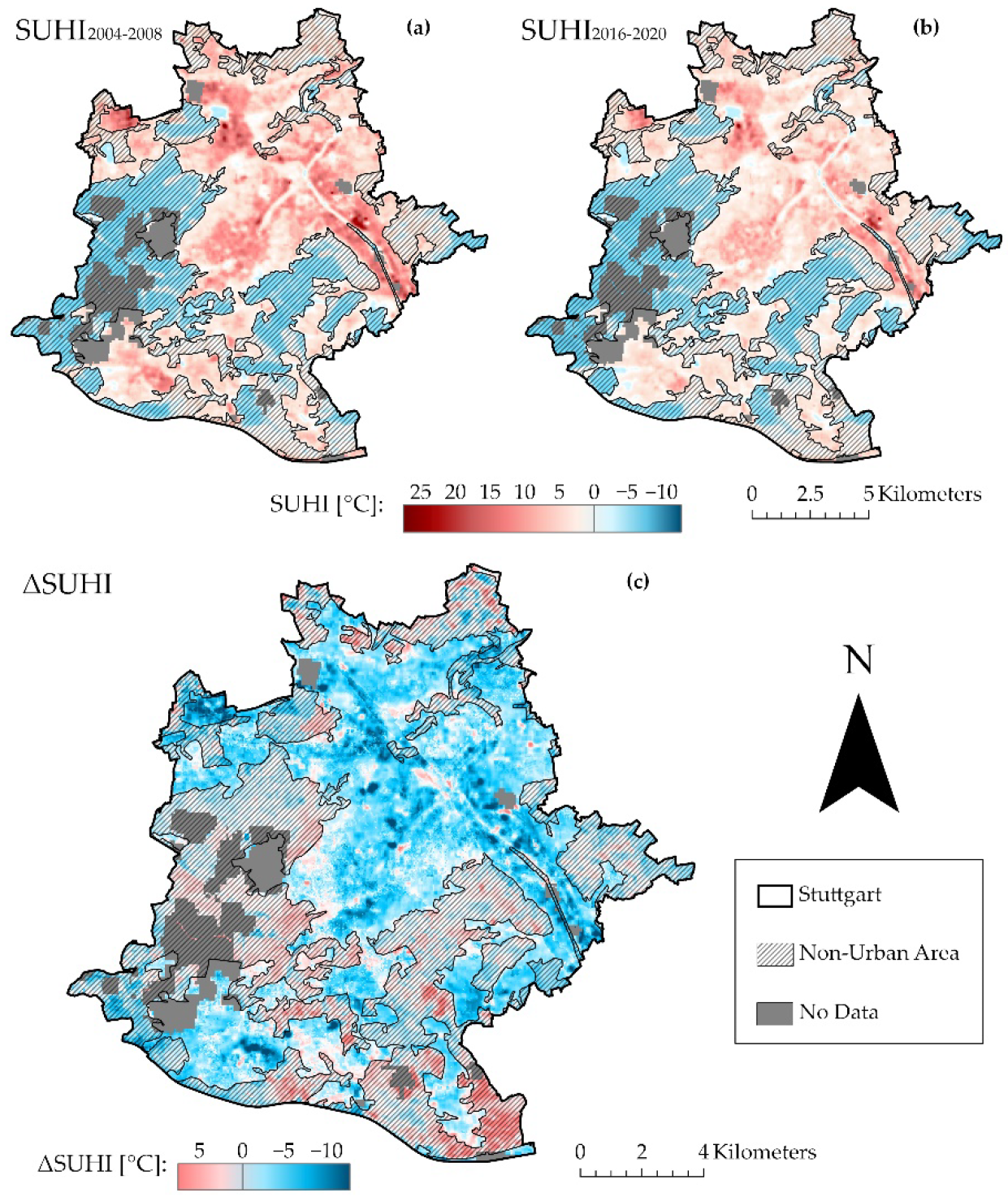
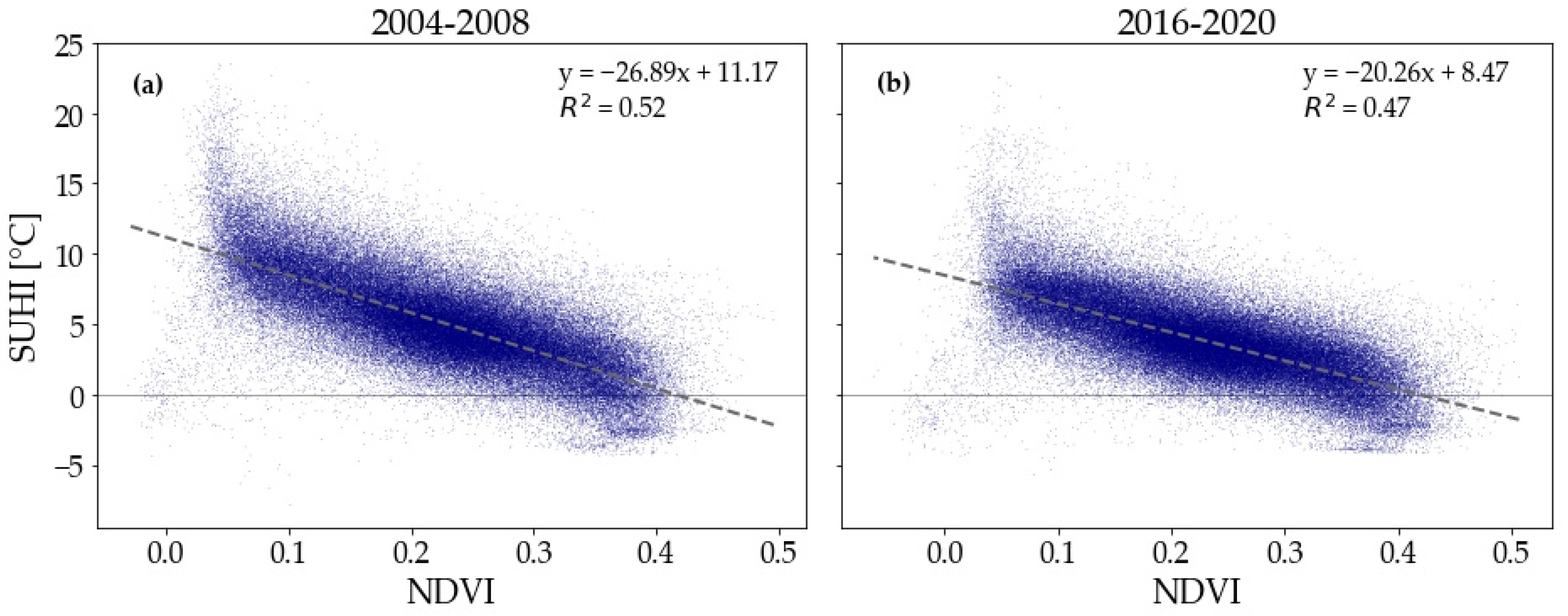
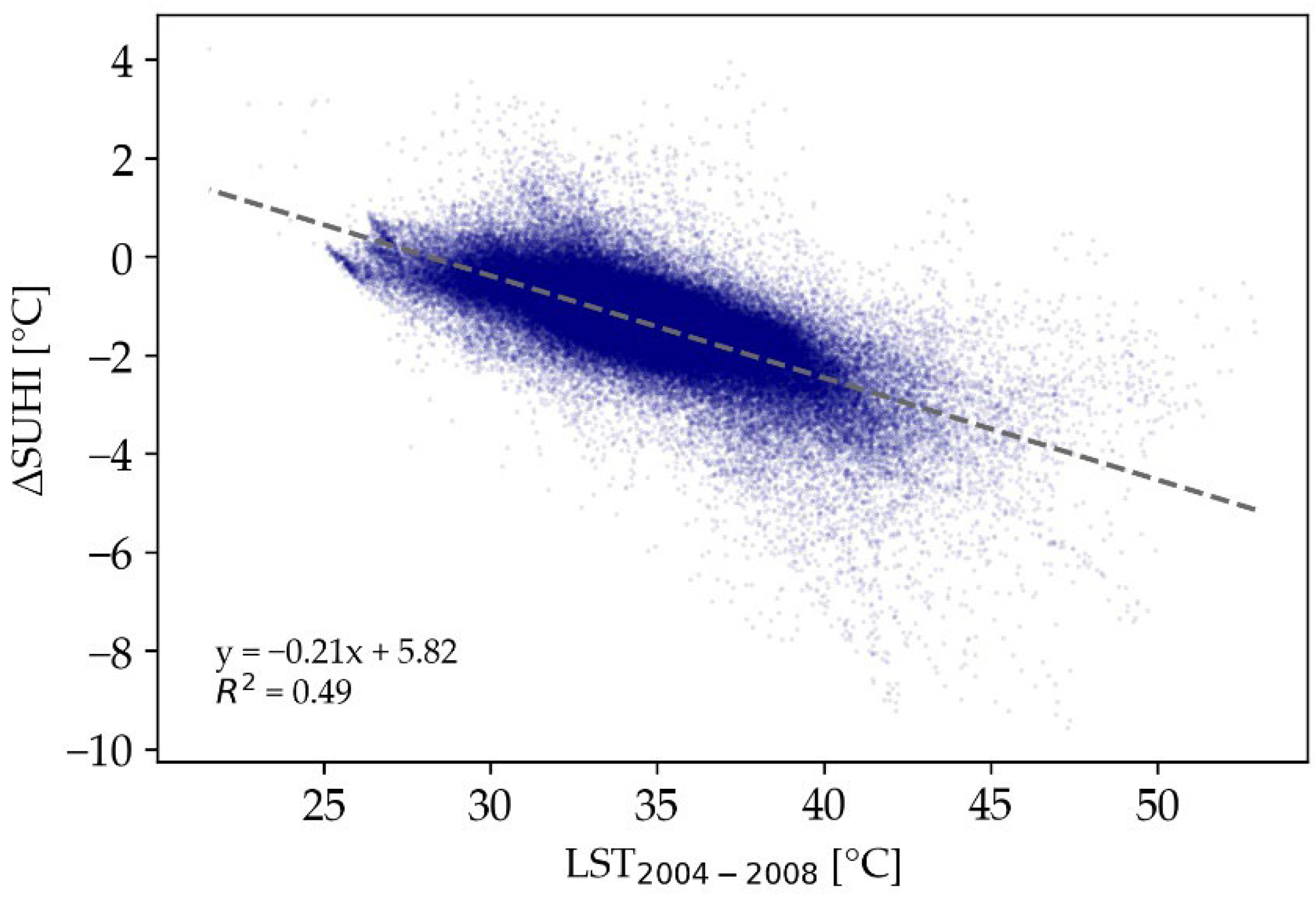
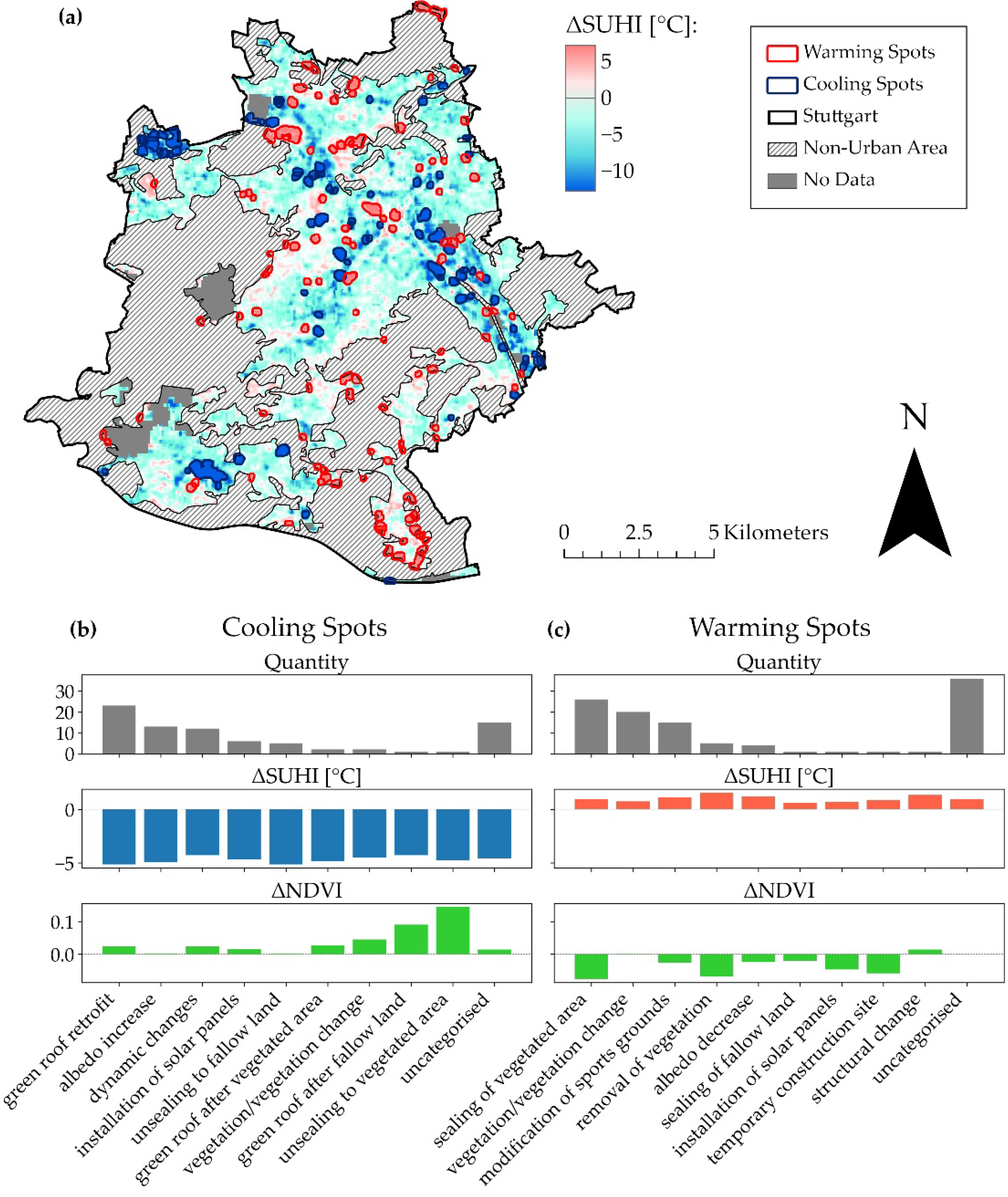
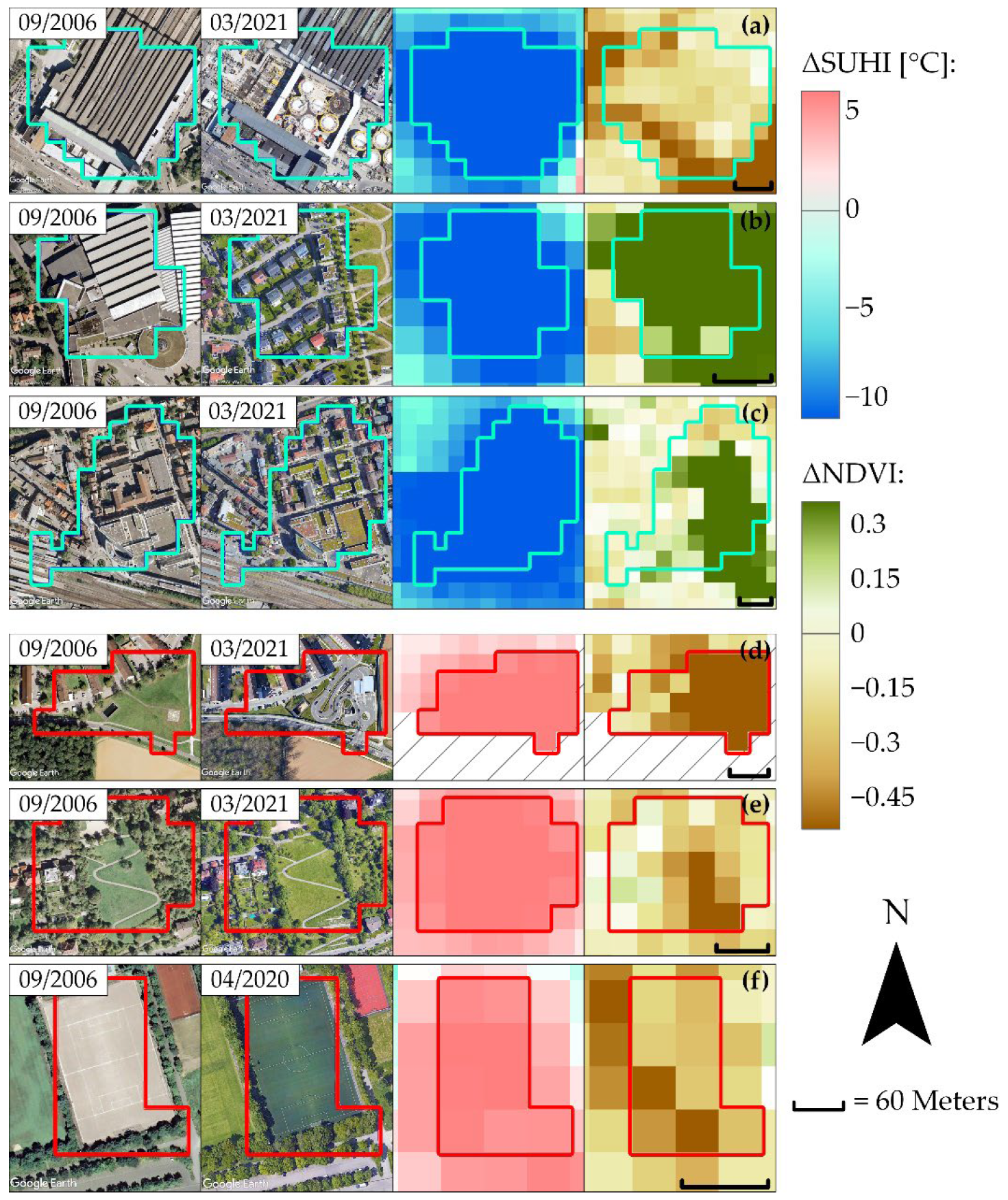
| Warming Spots | Cooling Spots |
|---|---|
| sealing of fallow land | unsealing to fallow land |
| sealing of vegetated area | unsealing to vegetated area |
| albedo decrease | albedo increase |
| installation of solar panels | installation of solar panels |
| vegetation/vegetation change | vegetation/vegetation change |
| removal of vegetation | green roof retrofit |
| modification of sports grounds | green roof after fallow land |
| temporary construction site | green roof after vegetated area |
| structural change | dynamic changes |
| uncategorised | uncategorised |
Publisher’s Note: MDPI stays neutral with regard to jurisdictional claims in published maps and institutional affiliations. |
© 2022 by the authors. Licensee MDPI, Basel, Switzerland. This article is an open access article distributed under the terms and conditions of the Creative Commons Attribution (CC BY) license (https://creativecommons.org/licenses/by/4.0/).
Share and Cite
Seeberg, G.; Hostlowsky, A.; Huber, J.; Kamm, J.; Lincke, L.; Schwingshackl, C. Evaluating the Potential of Landsat Satellite Data to Monitor the Effectiveness of Measures to Mitigate Urban Heat Islands: A Case Study for Stuttgart (Germany). Urban Sci. 2022, 6, 82. https://doi.org/10.3390/urbansci6040082
Seeberg G, Hostlowsky A, Huber J, Kamm J, Lincke L, Schwingshackl C. Evaluating the Potential of Landsat Satellite Data to Monitor the Effectiveness of Measures to Mitigate Urban Heat Islands: A Case Study for Stuttgart (Germany). Urban Science. 2022; 6(4):82. https://doi.org/10.3390/urbansci6040082
Chicago/Turabian StyleSeeberg, Gereon, Antonia Hostlowsky, Julia Huber, Julia Kamm, Lucia Lincke, and Clemens Schwingshackl. 2022. "Evaluating the Potential of Landsat Satellite Data to Monitor the Effectiveness of Measures to Mitigate Urban Heat Islands: A Case Study for Stuttgart (Germany)" Urban Science 6, no. 4: 82. https://doi.org/10.3390/urbansci6040082
APA StyleSeeberg, G., Hostlowsky, A., Huber, J., Kamm, J., Lincke, L., & Schwingshackl, C. (2022). Evaluating the Potential of Landsat Satellite Data to Monitor the Effectiveness of Measures to Mitigate Urban Heat Islands: A Case Study for Stuttgart (Germany). Urban Science, 6(4), 82. https://doi.org/10.3390/urbansci6040082






